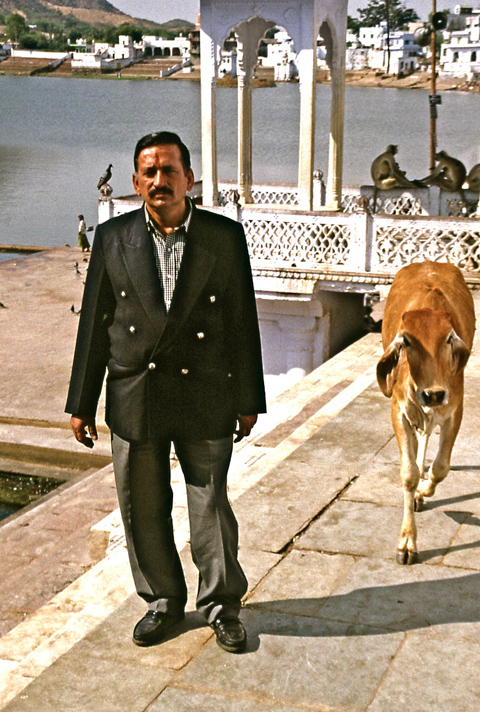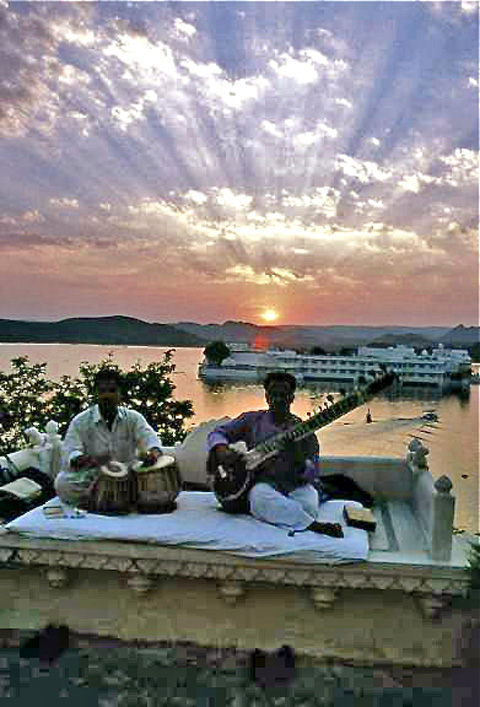November 1, 1999 | Travel Feature
Temple bells ring; the family joins guests for drinks at Deogarh Mahal. Photo: Steven Richter
India is everything the cognoscenti told us. It is a turbulence of color, an astonishment of monumental hand-hewn caves and ancient temples, a buzzing hive of one billion people -- friendly, proud, clever, curious, ambitious, devout, often heartbreakingly poor, and, on the street, relentlessly beseeching the traveler to "just take a look" at brass and stone carvings, carpets and pashmina shawls, sequined textiles, supposedly antique saris and painted miniatures, irresistible trash and treasures. Charting our course in Rajasthan, India's western land of the warrior clans, the two of us -- me and my mate, photographer Steven Richter -- long for total immersion.

Basant was the perfect driver, discovering Rajasthan for the first time with us. Photo: Steven Richter.
Everyone warned us about traveling in India -- Indian expats, friends just returned from their first excursion, pals so in love with this vast astonishing country that they visit twice a year. There was the smog. The hassles. The meaningless schedules. "The only way to travel in India, if you can afford it, is in an air-conditioned car with a driver," an American artist living in Benares told me.
The tank at Pushkar is sacred. “No Photographs” says the warning. Photo: Steven Richter
Having spent January stewing in chaotic airports crisscrossing southern India, we are thrilled that the next phase of our journey, a two-week tour of Rajasthan, can be done by car. Gourmands of the road, we want to see, buy, and eat everything wonderful.
“Do Not Litter” reads the sign behind this Sadhu lolling near a temple. Photo: Steven Richter
We ask our Delhi travel agent to book us into heritage hotels -- inns housed in restored forts and medieval castles. As for the driver and car, we brace ourselves to see what fate grants us for Rajasthan. We will be dancing with this guy for 12 days.
"My name is Basant," he says, directing the porters loading the Contessa's roomy trunk outside our hotel in Delhi. "Basant, it means spring." Good start. Not only does he speak English, but I can understand his English. Off we go in a welcome blast of cool air.
Neerama Fort Palace is one of India's handsomely restored heritage hotels. Photo: Steven Richter
The rugged Neemrana Fort-Palace, built ovaler five centuries -- parts of it dating from 1464 -- was nine levels of ruins when a pair of bold designers wrenched it back from decay, the first of their six sophisticated heritage hotel restorations. This one is just two hours from Delhi, and each suite and spacious room, done in antiques and folk art, has its own breakfast terrace and a name. Even the bathroom has a name: Loo Mahal.
A small step stool lets me climb into the tall colonial bed in the spiffy red-and-black Mahal Malabar, a glorious space filled with art. I can feel the wood through the modest mattress. That's typical in India. They don't believe in springs. We're not wild about the French "Eat Yourself Slim" dining room but love the Euro-Indian buffet lunch, the eclectic crowd, and the two cows having sex as we walk through the nearby village. After al, it's Valentine's Day.
Mr. Basant (I call him Mr. Basant even though that's his first name) is game for almost any detour we devise. But he's in charge of lunch, refusing to stop en route to Jaipur until he comes to a restaurant he deems safe. He is Hindu, a Brahmin, a vegetarian. He joins us for a simple but delicious vegetarian lunch served on a copper thali -- rice in the middle, potatoes, eggplant, saucy lentil dal all around to mix in. We eat with our fingers, using freshly baked chapati (a pita-like bread) as a scoop. We drink Coke and then sensational spicy masala tea with milk. When the bill comes -- a shockingly high $5 each -- Mr. Basant scolds the owner. ‘
"My lunch is free because I brought them here."
Near Samode we passed this group of women gathering for a temple visit. Photo: Steven Richter
Clucking his head, the owner obeys. Afterward, on our detour to see the stunning pink sandstone Samode Palace, we stop in a small village to photograph these Rajasthani women.
Moving by car we can stop anywhere as when amazing powdered colors catch our eye. Photo: Steven Richter.
After two sybaritic nights at Oberoi's ultra-posh Rajvilas outside Jaipur and a night at Taj's legendary Rambagh Palace in Jaipur proper, we've become attached to Mr. Basant, who's always early, always washing the car, always buying our bottled water so we won't get ripped off. We cancel our flight Udaipur so we can drive, and we get our travel agent to book us a room midway along, in Pushkar.
Pushkar is small, easy to explore, great for shopping. Mr. Basant bargains for us and smiles as I get my price for three dowry purses, an embroidered patchwork hanging, and a weird woven camel belt Steven must have. Our driver-escort-interpreter insists on carrying our booty. I could get used to this luxury. We join a wedding parade and are covered with sweet-smelling leis by the groom's brothers.
Suddenly all the lights go out in Pushkar. Abruptly, Mr. Basant pushes us into a shop. What's up? I wonder. Then I see he's saved us from walking into exploding firecrackers. Starved by now, we find fabulous pizza at an alfresco spot called Al Fornaio (after a 50-minute wait, also typical of India.). Early the next morning we visit the holy tank, where we get blessed. Mr. Basant saves me from walking into a cow. And Steven gets a great barbershop photo.
Pushkar is small and accessible so you can wander in and out of shops: Photo: Steven Richter
An Englishwoman in Delhi had urged us to take time for a night in Deogarh, a feudal state between Jodhpur and Udaipur where she goes periodically to restore her soul. There, on top of a hill, the sons and nephew of Deogarh's chieftan, Rawat Nahar Singhji, have restored the family's crumbling fort as a marvelous small heritage hotel that's seriously inexpensive. Just eight suites with balconies and 20 double rooms, many of them mirrored and set with colored glass in the Rajasthani-style. "You're in the Kama Sutra suite," we're told with a wink as we're delivered to a small suite with funky old furniture and a modern bath. Sure enough, there on the ceiling are frescoes of exotic sex acts. As temple bells sound in the village, guests gather for drinks with the family before dinner. An all-you-can-eat breakfast, with maybe the best marmalade I've ever tasted, is served on the topmost roof terrace.
Jaisalmer on the desert’s edge is exotic, walkable, frozen in time. Photo: Steven Richter
More than Jaipur, the fabled Pink City, more than Udaipur or Jodhpur, all Rajasthan musts, we loved Jaisalmer -- exotic, walkable, frozen in the past, as the guidebook promises, a desert fort straight out of tales from the Arabian Nights. As in Venice, you needn't worry about getting lost here because all roads circle back to where you want to be. Narrow, winding streets take you into the domestic life of its people. After you've explored the massive fort and the streets of exquisite old havelis (mansions), steel yourself to bargain for the ridiculous and the siblime, perhaps a colorful turban or the woodblocks used to print fabric. There is apparently no truly luxe lodging hereabouts, but we like the Narayan Niwas Palace for its location and survive the rigors of our minimal bedchamber.
My camel kept walking into trees, trying to brush me off his back. Photo: Steven Richter
"Will the there be pillows and enough blankets?" I ask Mr. Desert, the swashbuckling Marlboro Man of India. Alas, I forget to ask if the sheets will be laundered. A wealthy Mexican woman has recommended his safaris, and I can see why. He is a gawjus hunk. Still, this is definitely a low-rent safari: by jeep from Jaisalmer to the desert's edge, then on camel. I guess the $13 price should have been the giveaway.
Mr. Desert -- he got the name in a state beauty pageant to choose the best-looking man in traditional dress -- serves dinner, good enough grub, with chapatis baked over an open fire in the sand by his minions. Then he jeeps back to his harem or whatever in town, leaving us tentless to sleep under shredding, stained comforters, dazzled by the bracing night air and a zillion stars.
Originally published in Diversion magazine, November 1999
***
Raj Style

Sun sets over Taj’s Lake Palace Hotel in Udaipur as musicians from Fateh Prakash Palace play. Photo: Steven Richter
When calling India from the United States, preface phone numbers with 011-91.
We flew to New Delhi from New York on Air India (800 22 7722). For travel within India, we worked with Mr. Chaman Thakur at Creative Travel in New Delhi (11/26872257; fax: 11/26885886 or 11/26889764; e-mail creative@travel2india.com). Our driver, Basant Pandey, and his air-conditioned Contessa, were also booked through Creative Travel.
The Neemrana Fort-Palace in Alwar can be booked by calling the hotel directly (1494246006; fax: 1145566605).
Rajvilas, in Jaipur, can be booked through Oberoi hotels at 800 562 3764.
The Umaid Bhawan Palace Hotel in Jodhpur can be contacted by calling 9314503423 or visiting their website
We loved the mirrors and colored glass at Deogarh. I hope it’s not been spiffed up too much.Photo: Steven Richter.
The Deogarh Mahal (Deogarh, Madaria), can be contacted at 2904-252777 or email info@deogarhmahal.com
The Rambagh Palace in Jaipur can be booked at 866 969 1 825 or at the Taj Hotels website.
Finally, while I did not mention this hotel in the story, we also loved the Fateh Prakash Palace Hotel in Udaipur (294 2528016; fax: 294 252 8006) or book online here.
This article first appeared in Diversions, November 1999.
|
|